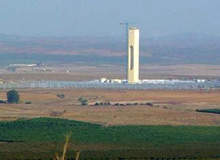In another thread ...
View attachment 274789View attachment 274790
Kind Regards, John
Edit: Didn't work - I'll try again ...
Haze now gone, and garden air temp about 32.2°C . After about 10 mins in full sun (hard to photograph because of sun - reads 56.6°C) ....What would be an appropriate de-rating factor for the cable when inside a black conduit that was being heated by solar radiation ?Just conducted as experiment, 2 feet of 25mm black conduit horizontal in free air and in direct sunlight with a mercury in glass thermometer inside the conduit, .... After 10 minutes the temperature inside the conduit was 110°F = 43.333°C.
I've just had a go with some flexible black conduit, and, even with the haze (virtually no shadows), got figures very similar to yours. Assuming tomorrow is less hazy (and even hotter), I'll try again tomorrow and report back!
View attachment 274789View attachment 274790
Kind Regards, John
Edit: Didn't work - I'll try again ...



